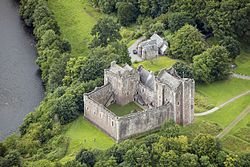The Earl of Moray | |
|---|---|
 Doune Castle, owned by the Earls of Moray | |
| Lord High Commissioner | |
| In office 1686–1688 | |
| Monarch | James II & VII |
| Preceded by | Duke of Queensberry |
| Succeeded by | Duke of Hamilton |
| Secretary of State in Scotland | |
| In office 1680–1686 | |
| Monarch | Charles II (1680–1685) |
| Preceded by | Duke of Lauderdale |
| Succeeded by | Earl of Melfort |
| Extraordinary Lord of Session | |
| In office 1680–1681 | |
| Monarch | Charles II |
| Commissioner of the Treasury | |
| In office 1678–1679 | |
| Monarch | Charles II |
| Lord Justice General | |
| In office 1675–1676 | |
| Monarch | Charles II |
| Personal details | |
| Born | Alexander Stewart 8 May 1634 (baptised) Darnaway Castle |
| Died | 1 November 1701 (aged 67) Donibristle |
| Resting place | Dyke, Moray |
| Nationality | Scottish |
| Spouse | Emilia Balfour (1646–1683) |
| Children |
|
| Parents |
|
| Residence | Darnaway Castle |
| Occupation | Politician |
Alexander Stuart, 5th Earl of Moray, KT, PC (8 May 1634 – 1 November 1701) was a Scottish peer who held senior political office in Scotland under Charles II and James VII and II.
He was first brought into government in 1676 by the Duke of Lauderdale, his relative by marriage; between 1681 and 1686, he played a prominent role in the suppression of Presbyterian radicals, known as "the Killing Time". He retained his position when James succeeded in 1685 and supported his religious policies, having converting to Catholicism in 1686.
Removed from office after the 1688 Glorious Revolution, he retired from public life and died at Donibristle on 1 November 1701.